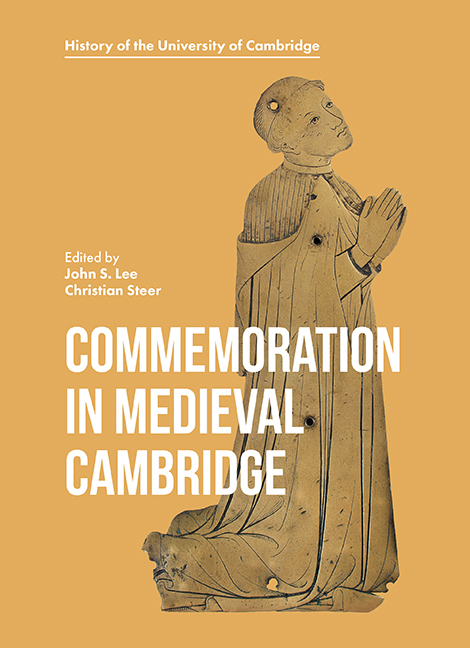Book contents
- Frontmatter
- Contents
- List of Illustrations
- Acknowledgements
- List of Contributors
- Abbreviations
- Introduction: In Fellowship with the Dead
- 1 Monuments and Memory: A University Town in Late Medieval England
- 2 The Commemoration of the Living and the Dead at the Friars Minor of Cambridge
- 3 The City of London and the Founding of the Guild of Corpus Christi
- 4 Patrons and Benefactors: The Masters of Trinity Hall in the Later Middle Ages
- 5 A Comparison of Academical and Legal Costume on Memorial Brasses
- 6 Commemoration at a Royal College
- 7 Cambridge Commemorations of Lady Margaret Beaufort's Household
- 8 ‘The Stones are all disrobed’: Reasons for the Presence and Absence of Monumental Brasses in Cambridge
- Bibliography
- Index
Introduction: In Fellowship with the Dead
Published online by Cambridge University Press: 25 October 2019
- Frontmatter
- Contents
- List of Illustrations
- Acknowledgements
- List of Contributors
- Abbreviations
- Introduction: In Fellowship with the Dead
- 1 Monuments and Memory: A University Town in Late Medieval England
- 2 The Commemoration of the Living and the Dead at the Friars Minor of Cambridge
- 3 The City of London and the Founding of the Guild of Corpus Christi
- 4 Patrons and Benefactors: The Masters of Trinity Hall in the Later Middle Ages
- 5 A Comparison of Academical and Legal Costume on Memorial Brasses
- 6 Commemoration at a Royal College
- 7 Cambridge Commemorations of Lady Margaret Beaufort's Household
- 8 ‘The Stones are all disrobed’: Reasons for the Presence and Absence of Monumental Brasses in Cambridge
- Bibliography
- Index
Summary
How did the people of medieval Cambridge choose to be remembered after their deaths? They could opt for prayers, Masses and charitable acts, tomb monuments, liturgical furnishings and other gifts in the town's parish churches and religious houses, while the university and its colleges also provided intercessory services and resting places for the dead. The role of memory and commemoration in this English university town was explored in a weekend conference organised by the Monumental Brass Society at Trinity Hall, Cambridge, in April 2013. This collection of essays is based on several of those papers, examining the themes of ‘Town and Gown’, together with others, commissioned for this volume, which consider the celebration of the dead more broadly, the location (and loss) of tomb monuments, their purpose and iconography and the mnemonics used for ‘pray and display’. The aim has been to explore what might have been distinctive about commemoration in medieval Cambridge and an important theme has emerged: the role of academic colleges, as part of the broader Church family and as commemorative institutions for founders and fellows. This dual role preserved the memory of the dead within the teaching of the living, although not all Cambridge men chose to be buried in their colleges. The example of Walter Crome, Cambridge fellow and London rector, ably demonstrates the multiplicity of commemoration as practised by college men in the later Middle Ages.
Walter Crome was fellow of Gonville Hall, Cambridge, and rector of St. Benet Sherehog in the city of London. He drew up his will on 5 August 1452 and died in the summer of 1453. Crome asked to be buried close to the tomb of his predecessor Thomas Dale, who had died in 1442, in the chancel of their London parish church. He further directed that his grave was to be covered by a square memorial stone and engraved with an inscription recording his name and date of death. Neither Crome's nor Dale's tomb was recorded by the London antiquarian John Stow in the account of the church in his great Survey of London, first published in 1598.
- Type
- Chapter
- Information
- Commemoration in Medieval Cambridge , pp. 1 - 9Publisher: Boydell & BrewerPrint publication year: 2018



